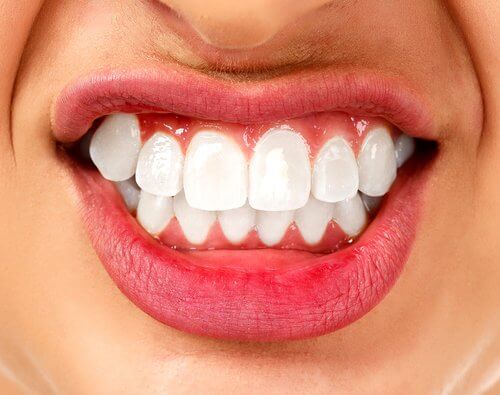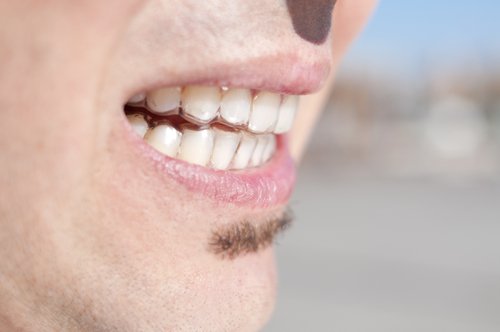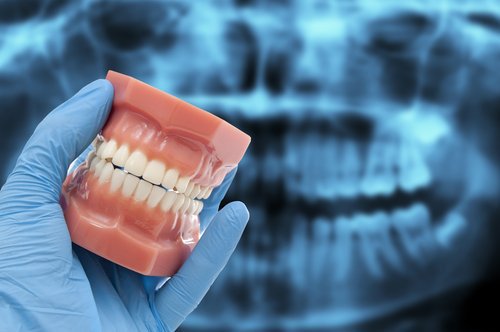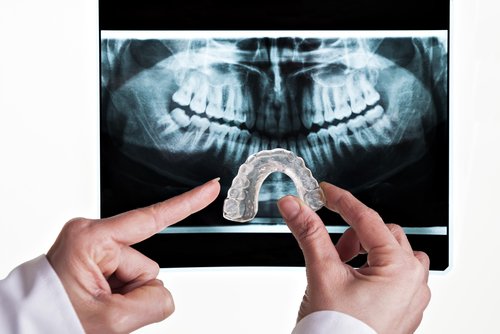Bruxism: A Psychosomatic Disorder

The habit of grinding your teeth involuntarily, especially at night, is a very common problem in adolescents. However, some adults do it as well. This psychosomatic disorder called bruxism can cause headaches, jaw pain, and earaches, along with damaged teeth. In this article, you can find out more about this psychosomatic disorder.
What you should know about this psychosomatic disorder
Bruxism can develop at any moment in life, although most patients are between 17 and 20 years of age when they begin to develop this habit. In regard to remission, it can disappear just as it started (without treatment). Or it could last for several years if you’re dealing with chronic bruxism.
This habit generally starts in relation to periods of anxiety, genetic factors, and even allergies. Hhowever, most accepted theory is that stress is what unleashes it. It doesn’t develop because of intestinal parasites, unlike what some people believe.
It can be divided into different types:
Centric bruxism

This happens when the individual tightly clenches their teeth, thus causing neck pain. The premolars are most damaged, and one common symptom is tension headaches.
Excentric bruxism
This refers to the grinding of upper and lower teeth, creating noises and fast jaw movements. This wears teeth down (especially the incisors) and could cause teeth to break and fall out.
Nocturnal bruxism
This takes place while you’re sleeping, and those that suffer from it don’t realize it. It appears during sleep stages 2 and 3, not during REM. If you sleep 8 hours a night, each episode will last between 15 and 40 minutes.
Awake bruxism
Although individuals don’t notice it, they grind or clench their teeth very strongly when under pressure at work or school. This condition is related to work stress and personal problems.
Read this article too:
Three Home Remedy Solutions for Bruxism
Why is bruxism a psychosomatic disorder?
Grinding your teeth is one way a lot of people release tension caused by obligations, pressure or difficulties in life. Although a lot of people think bruxism can be treated (and cured) after a few visits to the dentist, you’ll most likely need to see a psychologist.
The truth is, you need an approach from both medical specialists. The dentist is in charge of improving or treating worn down or broken teeth, while the therapist can try to find the reason you have developed the habit. They’ll focus on stressful situations, anxiety or worries that the patient is experiencing.

Individuals suffering from bruxism aren’t aware of their habit, nor of the cause. This is considered to be a psychosomatic disorder and sometimes the diagnosis is easy, but the treatment is not so much.
Because it’s caused by periods of stress, it could also be accompanied by other symptoms, like headaches or neck pain. The University of Chile has done research on bruxism in relation to people’s lives.
They have shown one can suffer from bruxism for several years, experiencing periods of increased frequency or intensity, in relationship to pressure or problems the individual is facing.
The good news is that once it’s detected, family or friends can listen for the grinding, or the affected individual can begin to analyze symptoms, and seek psychological treatment.
Therapy will help the individual to express his/her fears, discomfort and worries. This helps them work with these issues so they don’t influence their daily life, thereby preventing a relapse into bruxism.
Treatment and prevention of bruxism

Among global and multi-disciplinary treatments of bruxism, you’ll find the following:
Dental treatment
Occlusal adjustments or a bite splint. The bite splint is placed in your mouth when getting ready to go to bed. This simply prevents teeth from breaking or becoming damaged, but it doesn’t get rid of the habit.
Psychological treatment

It’s important that a patient goes to therapy to determine what is causing their bruxism. Changing your attitude when facing problems or obligations is the first step for avoiding this problem.
Check out this article too:
Pharmaceutical treatment
In cases of bruxism that involve extreme stress, doctors can use tranquilizers or muscle relaxers, along with anxiolytics.
Physical treatment
When the facial pain from clenching your teeth tightly becomes too painful, therapists can offer massage or relaxation techniques for the neck and head.
Palliative treatment can also be used, however, it doesn’t prevent nor reduce bruxism.
Acupuncture treatment
Therapy using small needles to improve certain emotions, or to channel energy, can be used to relax a patient and prevent dental clenching while sleeping.
Relaxation treatment
Yoga, meditation and tai chi can be extremely useful for someone who suffers from bruxism. These disciplines relax the body, calm the mind, and reduce stress, nerves and anxiety.
In order to prevent new episodes of grinding or putting pressure on your teeth, you can:
- Practice sports that induce deeper sleep.
- Take naps during the afternoon.
- Do recreational activities, like listening to music or reading, before bed.
- Reduce caffeine consumption.
- Take relaxing baths at night.
- Apply moist heat to the face and neck.
All cited sources were thoroughly reviewed by our team to ensure their quality, reliability, currency, and validity. The bibliography of this article was considered reliable and of academic or scientific accuracy.
- Frugone R, R. C. (2003). BRUXISMO. Avances En Odontoestomatología. https://doi.org/ISSN: 0213-1285
- Firmani, M., Reyes, M., Becerra, N., Flores, G., Weitzman, M., & Espinosa, P. (2015). Bruxismo de sueño en niños y adolescentes. Revista Chilena de Pediatria. https://doi.org/10.1016/j.rchipe.2015.05.001
- González Soto, E. M., Midobuche Pozos, E. O., & Castellanos, J. L. (2015). Bruxismo y desgaste dental. ADM. https://doi.org/10.1109/INES.2016.7555128
- Vicuña I, D., Id A, M. E., & Oyonarte W, R. (2010). Asociaciones entre Signos Clínicos de Bruxismo, Ansiedad y Actividad Electromiográfica Maseterina Utilizando el Aparato Bite Strip® en Adolescentes de Último Año de Enseñanza Media (Secundaria). International Journal of Odontostomatology. https://doi.org/10.4067/S0718-381X2010000300007
- Bolaños, E., Gonzales, E., & Del Castillo, E. (2002). El bruxismo infantil. Odontología Pediátrica. https://doi.org/http://sicapacitacion.com/libmedicos/El bruxismo infantil.pdf
This text is provided for informational purposes only and does not replace consultation with a professional. If in doubt, consult your specialist.








